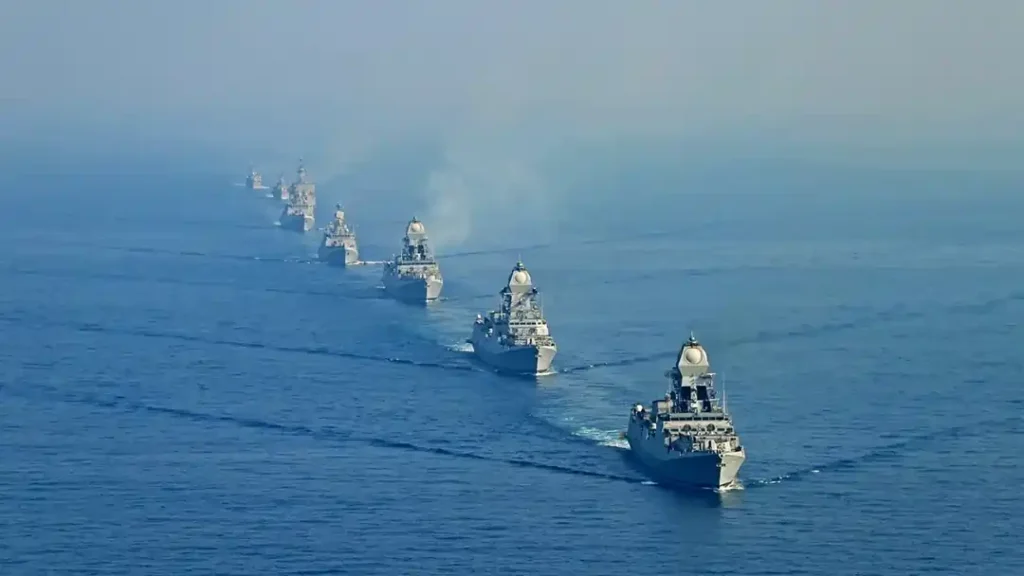New Delhi: The Indian Ocean Region (IOR), a critical artery for global trade and India’s economic lifeline, is witnessing escalating geopolitical tensions, primarily driven by China’s expanding naval presence and its strengthening military partnership with Pakistan. The Parliamentary Committee on External Affairs, in its report titled Evaluation of India’s Indian Ocean Strategy (IOR), presented in the Lok Sabha on August 12, 2025, has sounded a clarion call for India to bolster its maritime capabilities and strategic alliances to counter these emerging threats. Led by Congress MP Shashi Tharoor, the 31-member panel underscores the urgency of addressing the “China-Pakistan naval nexus” and China’s growing influence, which pose significant risks to India’s national security and regional dominance.

Geostrategic and Economic Significance of the IOR
The Indian Ocean holds unparalleled importance for India and the global community. India’s 11,098.81-kilometer coastline, encompassing approximately 1,300 islands and a 2.4 million square kilometer Exclusive Economic Zone (EEZ), underscores its strategic stake in the region. Globally, the IOR is the third-largest ocean, bordered by 35 littoral states that collectively host one-third of the world’s population. Economically, it is a vital conduit: 90% of India’s trade and most of its oil imports traverse these waters, while globally, the region accounts for 50% of container traffic, one-third of bulk cargo, and two-thirds of oil shipments.
Ecologically, the Indian Ocean’s status as the warmest ocean fosters a dynamic and biologically productive ecosystem, supporting fisheries and coastal livelihoods. However, this strategic and economic hub faces multifaceted challenges that threaten its stability and India’s leadership role.
Key Challenges in the Indian Ocean Region
The committee identifies three primary challenges in the IOR: geopolitical tensions, maritime security threats, and infrastructure gaps. Geopolitically, China’s assertive presence is a growing concern, driven by its Belt and Road Initiative (BRI) and the “String of Pearls” strategy. These initiatives involve significant investments in ports, airports, and logistics infrastructure across littoral states, often with dual-use military and commercial purposes. Notable examples include China’s military base in Djibouti and its deepening ties with Pakistan, which collectively aim to reshape the region’s strategic landscape in China’s favor.
Maritime security threats further complicate the scenario, encompassing piracy, terrorism, Illegal, Unreported, and Unregulated (IUU) fishing, smuggling, and drug trafficking. Infrastructure deficiencies in small island and coastal states exacerbate these vulnerabilities, limiting their capacity to address security and economic challenges effectively.
The Ministry of External Affairs (MEA) elaborated on these concerns in a written submission to the committee, highlighting threats to maritime traffic, piracy, terrorism, freedom of navigation and overflights, and the protection of sovereignty and independence. A significant issue is the increasing presence of extra-regional players, particularly China, which has been deploying research and survey vessels to collect sensitive oceanographic and marine data while advancing its maritime domain awareness.
China’s Naval Ascendancy and the China-Pakistan Nexus
The committee expresses alarm over China’s rapid naval expansion, which has positioned the People’s Liberation Army (Navy) as the world’s largest naval force, surpassing the United States Navy. With over 15 units commissioned annually, China’s fleet includes multiple Carrier Battle Groups and a third aircraft carrier, the Fujian, currently in advanced pre-commissioning trials. Regular deployments of Chinese submarines and naval vessels in the IOR since 2013 demonstrate a clear intent to consolidate strategic influence. In 2024 alone, Chinese naval ships made 22 port calls in IOR countries and conducted joint exercises with littoral states, while 20 quasi-military research vessels operated for 862 days—the highest activity since 2020.
Equally concerning is the strengthening China-Pakistan naval nexus, which facilitates joint military exercises and advances Pakistan’s naval modernization. Pakistan’s Navy is undergoing a significant capability upgrade, incorporating four Type 054 A/P frigates from China, four MILGEM Class Corvettes from Turkey, and eight Hangor (Yuan Class Air Independent Propulsion Capable) submarines from China, alongside advanced aircraft and unmanned assets. The committee warns that this cooperation could destabilize the regional balance of power, challenging India’s strategic autonomy and influence over key maritime chokepoints.
The report views China’s BRI and “String of Pearls” as deliberate attempts to dilute India’s maritime influence and reconfigure the IOR’s strategic geography in China’s favor, potentially undermining India’s sea-dependent economic growth. The panel also notes China’s growing engagement in Africa, exploiting reduced European Union influence, and its outreach to politico-military leaders in the region.
India’s Fragmented Strategic Frameworks
The committee critiques India’s current approach to the IOR as fragmented, pointing to overlaps between the Security and Growth for All in the Region (SAGAR) initiative and the proposed MAHASAGAR framework for the Global South. This overlap risks creating confusion in strategic objectives, undermining coherence and effectiveness. The panel asserts that India’s leadership in the IOR is a “natural and necessary extension” of its geopolitical and economic interests, positioning the nation as a guardian of this critical maritime space.
Strategic Recommendations for India
To counter these challenges, the committee proposes a multi-pronged strategy. It recommends upgrading SAGAR to MAHASAGAR, emphasizing sustainability, trade, and mutual security. Deepening multilateral engagement through platforms like the Quad, Indian Ocean Rim Association (IORA), and Bay of Bengal Initiative for Multi-Sectoral Technical and Economic Cooperation (BIMSTEC) is essential for fostering security and economic integration. Enhancing diaspora engagement and cultural diplomacy is highlighted as a means to strengthen India’s soft power in the region.
The panel advocates promoting a rules-based maritime order, supporting the United Nations Convention on the Law of the Sea (UNCLOS) and ASEAN centrality in Indo-Pacific governance. To address coordination gaps, it strongly recommends establishing an Inter-Ministerial Task Force involving key ministries—External Affairs, Defence, Commerce, Environment, Shipping, Finance, and Home Affairs—to streamline India’s strategic priorities in the IOR.
Militarily, the committee urges India to remain proactive in countering the combined naval threat from China and Pakistan. This includes bolstering deterrence through joint exercises with partner countries and enhancing Maritime Domain Awareness (MDA) using advanced technologies like satellite-based surveillance and artificial intelligence. A significant upgrade in naval capabilities is deemed critical, with recommendations for inducting advanced anti-submarine warfare (ASW) vessels, surveillance aircraft, and nuclear-powered submarines to address emerging threats.
India is actively engaging friendly nations through bilateral and regional forums, such as the Colombo Security Conclave, IORA, and Quad, to counter Chinese activities. The Ministry of Defence highlights the Indian Navy’s multifaceted challenges, including naval competition, territorial disputes, piracy, trafficking, illegal fishing, maritime terrorism, natural disasters, and complex geopolitical dynamics. China’s development of ports and infrastructure near India’s maritime boundaries further underscores its ambition to become a dominant maritime power.
Broader Context and Future Outlook
This report comes at a pivotal moment, just weeks before Prime Minister Narendra Modi’s anticipated visit to China for the Shanghai Cooperation Organisation Summit on August 31–September 1, 2025. Chinese foreign ministry spokesperson Guo Jiakun expressed hopes that the summit would mark a “new stage of high-quality development” characterized by greater solidarity and coordination. Meanwhile, the Indian Navy’s ongoing Theatre Level Operational Exercise (TROPEX) in the IOR underscores the urgency of the panel’s recommendations.
Conclusion
The Parliamentary Committee’s report serves as a vital blueprint for navigating the complex challenges in the Indian Ocean Region. By addressing China’s naval expansion, the China-Pakistan nexus, and infrastructure vulnerabilities, India can reinforce its position as a leading maritime power. Through enhanced alliances, technological advancements, and a unified strategic vision, the nation aims to secure its economic and security interests while promoting a stable, rules-based order in the IOR. As global attention focuses on this critical region, India’s proactive measures will be pivotal in shaping its maritime future.
Frequently Asked Questions (FAQs)
1. What is the significance of the Indian Ocean Region (IOR) for India?
The Indian Ocean Region (IOR) is critical for India due to its vast 11,098.81-kilometer coastline, approximately 1,300 islands, and a 2.4 million square kilometer Exclusive Economic Zone (EEZ). Economically, 90% of India’s trade and most of its oil imports pass through the IOR. Globally, the region handles 50% of container traffic, one-third of bulk cargo, and two-thirds of oil shipments. Ecologically, as the warmest ocean, it supports a dynamic and biologically productive ecosystem vital for fisheries and coastal communities.
2. What are the main challenges India faces in the IOR according to the Parliamentary Committee?
The Parliamentary Committee identifies three primary challenges: geopolitical tensions, maritime security threats, and infrastructure gaps. Geopolitically, China’s growing presence through the Belt and Road Initiative (BRI) and “String of Pearls” strategy, including its military base in Djibouti and ties with Pakistan, poses risks. Maritime security threats include piracy, terrorism, Illegal, Unreported, and Unregulated (IUU) fishing, smuggling, and drug trafficking. Infrastructure deficiencies in small island and coastal states further limit regional stability.
3. Why is the China-Pakistan naval nexus a concern for India?
The strengthening China-Pakistan naval nexus facilitates joint military exercises and advances Pakistan’s naval modernization, including the induction of advanced frigates, corvettes, and submarines from China and Turkey. This cooperation could destabilize the regional balance of power, challenge India’s strategic autonomy, and undermine its influence over key maritime chokepoints, posing significant risks to national security.
4. What recommendations did the Parliamentary Committee make to address these challenges?
The committee recommends upgrading the SAGAR initiative to MAHASAGAR, focusing on sustainability, trade, and mutual security. It calls for deeper multilateral engagement through platforms like the Quad, IORA, and BIMSTEC, enhanced diaspora engagement, and cultural diplomacy. Promoting a rules-based maritime order via UNCLOS and ASEAN centrality is emphasized. Militarily, it urges bolstering deterrence through advanced technologies, naval upgrades (e.g., anti-submarine warfare vessels and nuclear-powered submarines), and joint exercises with allies. It also proposes an Inter-Ministerial Task Force to streamline coordination.
5. How is China expanding its influence in the IOR, and what are the implications for India?
China is expanding its influence through infrastructure investments under the BRI and “String of Pearls,” including ports and logistics projects with dual-use purposes, and deploying research vessels to collect sensitive marine data. Its navy, now the world’s largest, commissions over 15 units annually and operates Carrier Battle Groups and submarines in the IOR. In 2024, Chinese ships made 22 port calls and conducted exercises with littoral states. These moves aim to reshape the region’s strategic geography, potentially diluting India’s maritime influence and threatening its economic and security interests.

